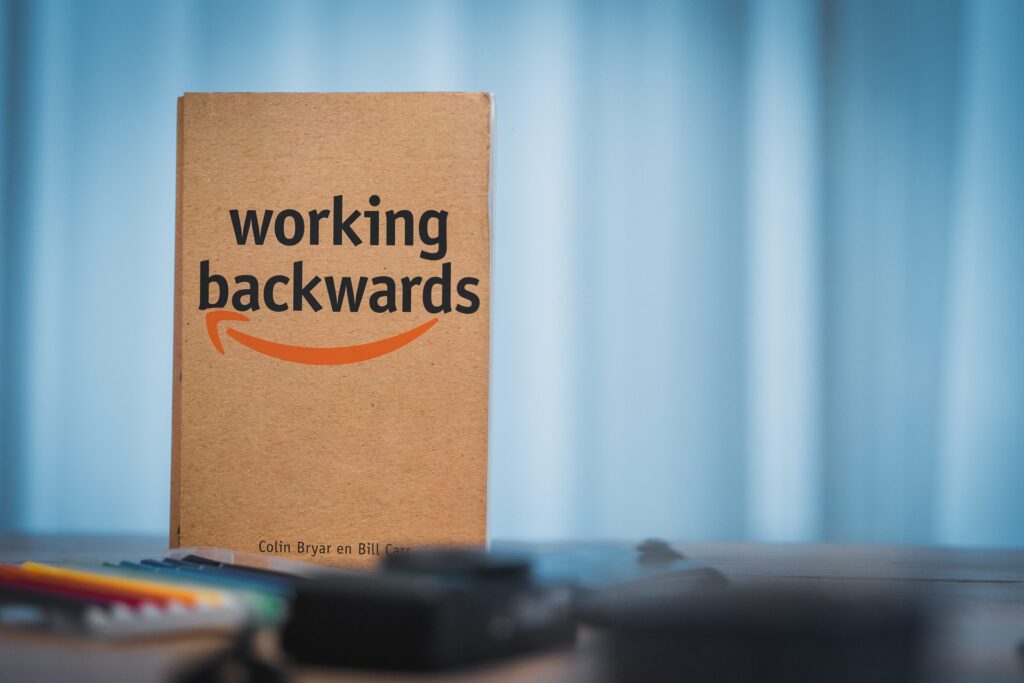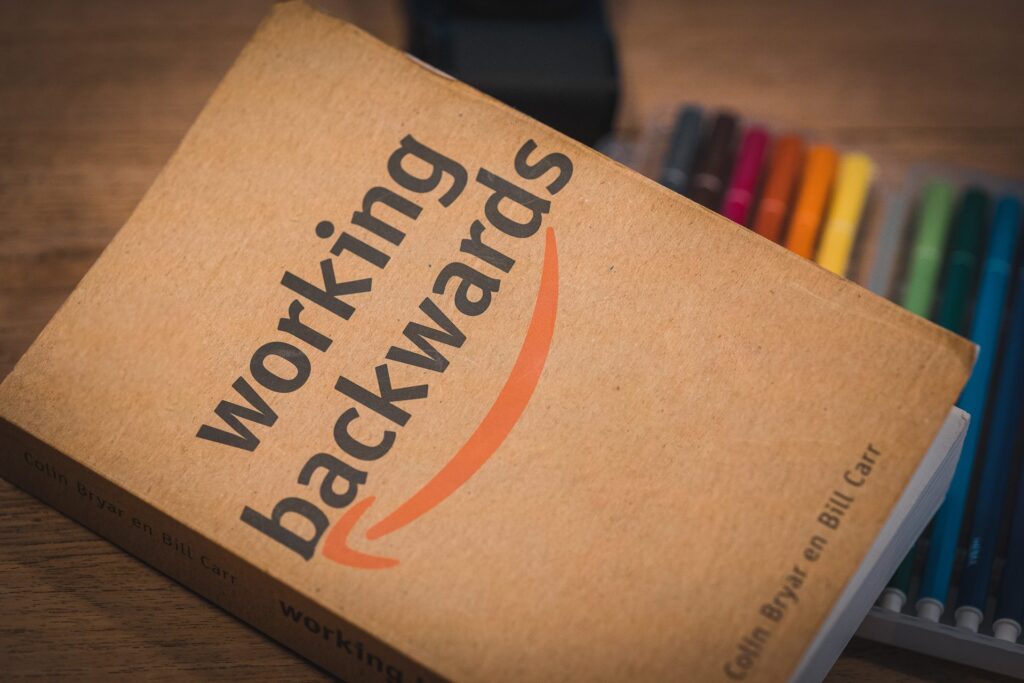7 Lessons from ‘Working Backwards’ by Amazon
Mark Vletter

Do you enjoy reading Mark’s articles? Sign up for his founder’s newsletter now and stay up to date with his latest writings.
My goal when reading is learning. I learn a little by reading, I learn more by doing, and I learn most by reflecting on the experience I had while doing. That means this book review is not a summary of the book, but a “Top 7” of the most important things you can learn from “Working Backwards”.
The book describes the inner workings of Amazon. I don’t like Amazon as a company. They have been very successful commercially at the expense of workers peeing in bottles, getting lousy pay, and at the expense of the planet. This, however, does not mean you can’t learn from this economic giant. These seven things I learned from Amazon.
This blog was originally published on the website of Voys South Africa.
1. Put (leadership) principles on paper
Principles describe the behavior you expect from your colleagues and from yourself. Where Working Backwards talks about leadership principles, I think everyone is a leader in the work they do within an organization. At Voys, we believe that our principles apply to everyone in the organization.
But of course it doesn’t work that way for every company. Organizations such as Philips have a short list of principles that apply to the entire organization. That list is supplemented with leadership principles for management.
What exactly do you record when you put your principles on paper? For me, the culture of an organization equals its behavior. At Voys, this behavior stems from our values and the fact that we work in a self-directed way, which requires different behavior. Our principles are therefore based on our culture, our values and the fact that we are self-managed.
Putting your principles on paper is helpful because it creates clear expectations. You can test not only the behavior of your colleagues, but also your own behaviour. This is useful for existing colleagues and when hiring new people.
2. Raise the bar when recruiting new colleagues
Hiring new people is a big part of the book. What Amazon does is add a person who really lives the principles to the hiring process. This person’s job is to raise the bar of the people who come into the organization. This colleague also helps teams to hire the right people. An independent third party lowers the risk of someone being hired ‘because we really need reinforcements’.
We have not yet added this bar raiser to our hiring process, but we do have a way to test whether candidates fit our aforementioned principles. As with Amazon, we use a lot of STAR questions in the process:
- What was the situation?
- What was the task?
- What actions have you taken?
- What was the result?
We want to test actual behaviour.
We do this during an introduction day. During this day, a candidate walks with our team to see if this person fits the organization and the people, and vice versa. I highly recommend this for anyone joining a new organization. It is pleasant for both the candidate and the organization, because you really get to know each other.
As with Amazon, we ask everyone involved in the process, the selection team filled with people the candidate will work with, to write a summary of their experience throughout the day. We do this without mutual consultation, that way colleagues cannot influence each other’s opinion. Written feedback should be thorough, detailed and specific.
What you can learn from Working Backwards in terms of hiring new colleagues is the following:
- Standardize the process
- Look for people who fit your organizational principles
- Add a bar raiser to the process
- Provide written notes to dispel prejudice
If I may add: an introduction day is a valuable addition to and a great tool for the recruitment process.

3. Use a rigid system for a flexible strategy
The book also describes how Amazon sets strategy and goals. At Voys, we use something we call the Outlook process that has many similar components. Because we are self-managing, we needed a distributed system to set a strategy and clear goals. We’ve made a four-part video series about this and we’ve written about it extensively in our book on self-direction.
4. Work with one team on one task
Part of Amazon’s system is that the company works with single-threaded leaders. Each Amazon project has a single leader whose sole focus is the project the leader has taken on. The team members also have a single focus on that project.
We copied this at Voys, and it works very well. We do see that Amazon works with larger teams than we do. We try to keep teams as small as possible, as we have found that this yields the best results. If a task becomes too large, it is often divided into two to keep it manageable for small teams.
Working Backwards recommends making sure that you are not dependent on other teams or people within projects and processes. We are big fans of this. We have also done this in the development process by building a service architecture . We have also built in many systems to make asynchronous working really work and to speed up and improve decision-making.
On the latter topic, I made a video in which I name six systems that help you make better decisions. If you would rather read about it, we have published a blog on the subject.
5. Communicate with stories and documents of up to six pages
PowerPoint is the boss in many organizations. This is not the case with Amazon. The information density of a PowerPoint presentation is low compared to written information. When a presentation is given, you notice that the presenter often has a lot of information in his head, information that you can’t get from the PowerPoint. That information is lost to the rest of the organization. It is also better to hide ambiguity when you give a presentation, especially if you are a strong speaker.
Amazon prefers documentation of up to six pages that is data-based and backed by a good story. That also means they take the time to read these pieces before a meeting starts so they can dig deep into the content.
We never use PowerPoint to communicate and strongly prefer short, written communication and information based on data. Amazon prefers six pages because it forces you to put the essentials on paper. I like linked information and that’s why we use blog a lot, a tool that is very strong at this. This also simplifies the use of the wisdom of the crowd , which I feel is underrepresented in the Amazon process. We have seen that with clear communication and transparent information you get relevant feedback from all parts of the organization.
What you can learn from Amazon here is that short pieces based on data and supported by good stories really help. I also believe this works better than PowerPoint. I would add that these documents should be living documents, allowed to live in a transparent environment such as Notion where everyone can contribute.
6. Start with the desired result
When Amazon wants to develop a new product or service, they start with the real value it brings to a potential customer. And they write that down by writing a press release.
This is followed by the frequently asked questions for the press and the customer, followed by an FAQ for the internal organization.
We copied this, and we now have developers writing press releases for features they want to develop, which is great. It helps them to start with the most important thing: the value the feature will have for the customer. While this is really nice and makes teams much more customer-centric, I think the real value is in the FAQ.
The best projects are slow at the beginning and fast at the end. That’s because they’re very clear and getting clarity takes time, but this helps with every part that follows.

7. Use input metrics you can influence
Many organizations register output metrics. For example, turnover, share price and EBIT. Amazon focuses on input metrics that teams can influence. We’ve been experimenting with metrics and KPIs for over ten years and I’ve written about this topic, yet I still find it very difficult. Metrics help to understand the entire customer journey. The input of one team often leads to output which in turn is the input for the next team. With that, you want metrics for the entire journey that your customer makes through the organization. Because finding one input metric is often difficult.
An example: suppose I write a blog, the number of articles written could be an input metric. But this metric has little value if I don’t know the result of the input. So I want to measure the number of website visits as well, something you can think of as an output metric.
But the website visits metric says little about the quality of the article and much more about the quality of the promotion I’ve done. And even if I did the promotion right and if it’s a really well written and received article, it might not lead to conversions. So I would also like to have conversions as an output metric.
Now you see that when writing, publishing and distributing blogs, every step of the customer journey is relevant. If I wanted to describe it in one metric, that could be “percentage of leads from articles written for our target audience,” which is a great metric that I can directly influence.
But if I wanted to create this metric, I would still need to know the same things:
- The number of articles written for a target group
- The number of website visits
- The number of conversions
So having journey metrics is easier and more useful – also for other roles in the organization – than having one input metric.
The concept of input metrics puts you on edge. And if you can find the perfect input metric for a process, one that can be directly influenced by the people working on the process, it’s extremely valuable.
The real value, in my opinion, lies in the focus on the customer experience: understanding the process that they go through and introducing measurement points in that journey.
In summary, you learn from this from Working Backwards
Long story short: what lessons do you learn from this book about Amazon?
- The value of principles
- How to build a better team with a better recruiting process
- The value of a rigid system for creating a flexible strategy
- The value of working single-threaded
- The power of written communication and six pagers
- How Working Backwards focuses your company on creating real customer value
- That you have to measure that on the basis of customer-oriented metrics that you can influence
I hope you learn a lot from the book. In addition, I hope that the lessons I have learned from the book will give you new insights that you can apply within your company! I’d love to hear more about your experiences, you can find me on Twitter as @MarkV.

